
The grey-shanked douc langur is a douc species native to the Vietnamese provinces of Quảng Nam, Quảng Ngãi, Bình Định, Kon Tum, and Gia Lai. The total population was estimated at 550 to 700 individuals in 2004. In 2016, Dr. Benjamin Rawson, Country Director of Fauna & Flora International's Vietnam Programme, announced a discovery of an additional population including more than 500 individuals found in Central Vietnam, bringing the total population up to approximately 1000 individuals.

The red-capped lark, Calandrella cinerea, is a small passerine bird. This lark breeds in the highlands of eastern Africa southwards from Ethiopia and Somaliland. In the south, its range stretches across the continent to Angola and south to the Cape in South Africa.
Lasiopogon ponticulus is a species of flowering plant in the family Asteraceae. It is found only in Namibia. Its natural habitat is cold desert. It is threatened by habitat loss.
The Cuban pine toad, or Schwartz's Caribbean toad, is a species of toad in the family Bufonidae. It is endemic to Cuba and found in western Cuba and on the Isla de la Juventud, below 70 m (230 ft) above sea level. Its natural habitats are savannas with pinewood, palms, and sandy soils. Breeding takes place in temporary pools, flooded pastures, and other shallow bodies of standing water; it can be abundant at breeding aggregations, but is otherwise hard to see. It is threatened by habitat loss caused by agriculture and sand extraction. Its habitat is also threatened by the invasive tree, Dichrostachys cinerea.
The Cuban high-crested toad, or Gundlach's Caribbean toad, is a species of toad in the family Bufonidae that is endemic to Cuba. It is found plains in all provinces as well as Isla de la Juventud and the Sabana-Camagüey Archipelago. The specific name gundlachi honors Johannes Christoph Gundlach, a German zoologist. Its natural habitats are primarily forests but also xeric and mesic grasslands. It is an explosive breeder of rain-flooded pools. It is threatened by habitat loss and degradation caused by agriculture, and by agricultural pollution. Its habitat is also threatened by the invasive tree Dichrostachys cinerea.

The ash-colored cuckoo is an American bird species of the cuckoo family (Cuculidae).
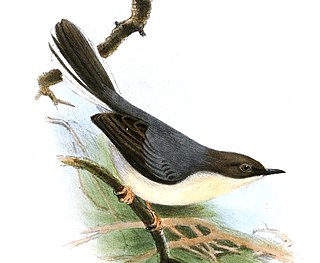
The grey apalis is a species of bird in the family Cisticolidae.

The Karoo scrub robin or Karoo Robin, is a species of bird in the family Muscicapidae. It is found in Lesotho, Namibia, and South Africa. Its natural habitats are dry shrubland and Mediterranean-type shrubby vegetation.
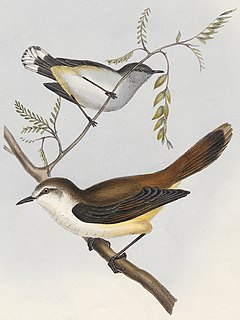
The grey thornbill, ashy gerygone or mountain gerygone is a species of bird in the family Acanthizidae. It is found in the highlands of New Guinea. Its habitat includes subtropical and tropical moist montane forests.

The Bahia spinetail is a species of bird in the family Furnariidae. It is endemic to Brazil.
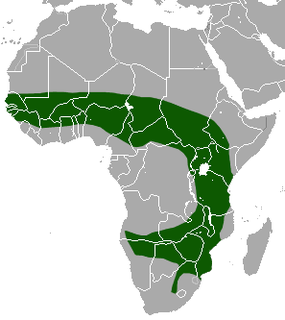
The bicolored musk shrew is a species of mammal in the family Soricidae. It is found in Angola, Benin, Botswana, Burkina Faso, Burundi, Cameroon, Central African Republic, Chad, Democratic Republic of the Congo, Ivory Coast, Ethiopia, Gambia, Ghana, Guinea, Guinea-Bissau, Kenya, Lesotho, Malawi, Mali, Mauritania, Mozambique, Namibia, Niger, Nigeria, Rwanda, Senegal, Sierra Leone, South Africa, Sudan, Tanzania, Togo, Uganda, Zambia, and Zimbabwe. Its natural habitats are dry savanna, moist savanna, subtropical or tropical dry lowland grassland, and hot deserts.

The lesser red musk shrew is a species of mammal in the family Soricidae. It is found in Angola, Botswana, Democratic Republic of the Congo, Malawi, Mozambique, Namibia, South Africa, Eswatini, Tanzania, Zambia, and Zimbabwe. Its natural habitats are dry savanna, moist savanna, subtropical or tropical dry lowland grassland, and hot deserts.
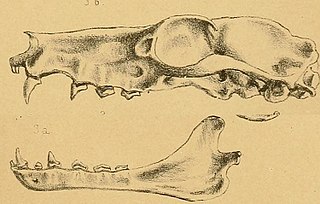
The Angolan epauletted fruit bat is a species of megabat in the family Pteropodidae. It is found in Angola and Namibia. Its natural habitats are dry savanna and moist savanna. It is threatened by habitat loss.
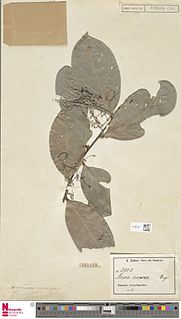
Dactyladenia cinerea is a species of plant in the family Chrysobalanaceae. It is endemic to Cameroon. It is threatened by habitat loss.

Aloe erinacea is a rare species of succulent plant in the genus Aloe, from arid areas of Namibia.
Antimima quartzitica is a species of plant in the family Aizoaceae. It is endemic to Namibia. Its natural habitat is rocky areas. It is threatened by habitat loss.
Brownanthus pubescens is a species of plant in the family Aizoaceae. It is endemic to Namibia. Its natural habitats are dry savanna and rocky areas. It is threatened by habitat loss.
Melicope cinerea is a species of plant in the family Rutaceae known by the common name manena. It is endemic to the Hawaiian Islands. It is threatened by habitat loss.
Phaedranassa cinerea is a species of plant that is endemic to Ecuador. Its natural habitat is subtropical or tropical moist montane forests. It is threatened by habitat loss.
Tylecodon aurusbergensis is a species of plant in the family Crassulaceae. It is endemic to Namibia. Its natural habitat is rocky areas. It is threatened by habitat loss.











